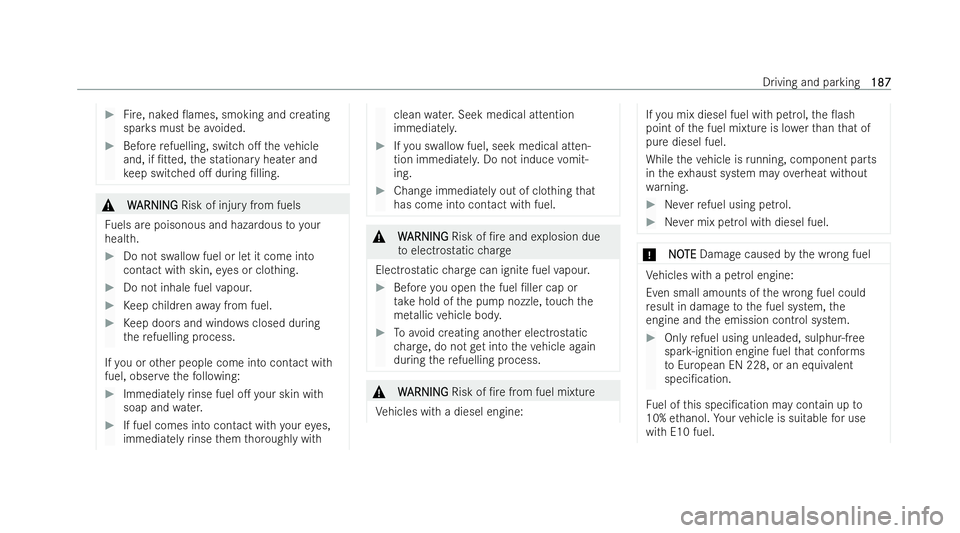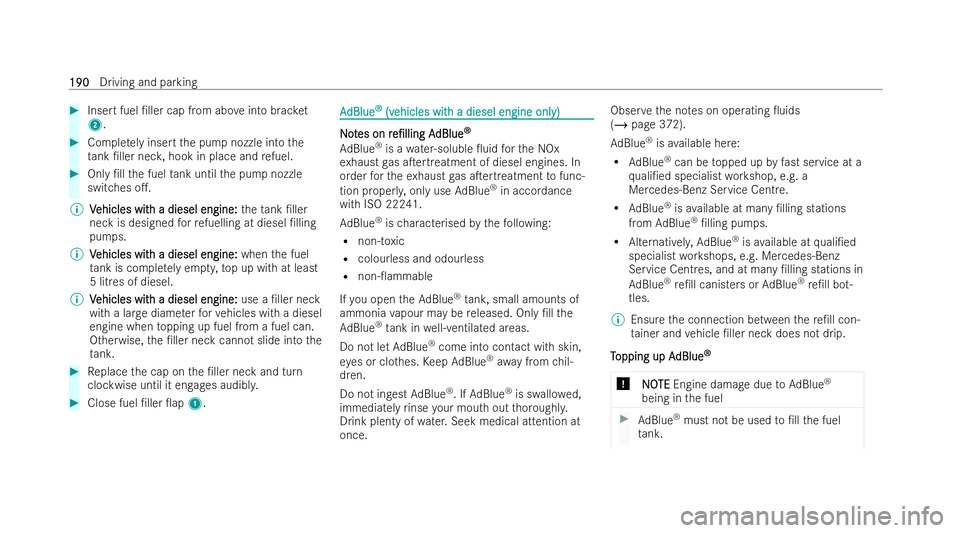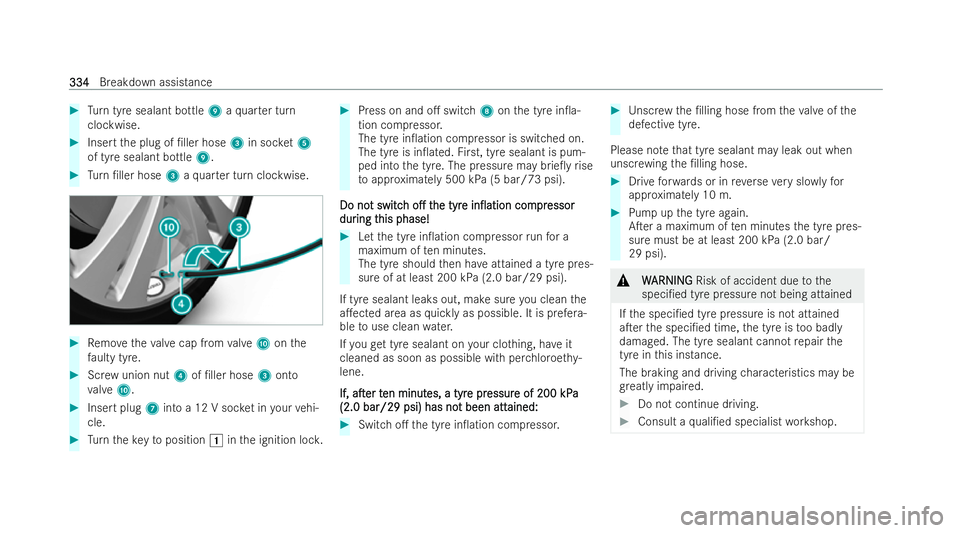Page 190 of 497

#
Fire , naked �0ames, smoking and creating
spar ksmust be avoided. #
Before refuelling, switch o�. theve hicle
and, if �/tted, the stationary heater and
ke ep switched o�. during �/lling. &
W
W ARNING
ARNING Risk of injury from fuels
Fu els are poisonous and hazardous toyour
health. #
Do not swallow fuel or let it come into
contact with skin, eyes or clo thing. #
Do not inhale fuel vapour. #
Keep children away from fuel. #
Keep doors and windo wsclosed during
th ere fuelling process.
If yo u or other people come into contact with
fuel, obser vethefo llowing: #
Immediate lyrinse fuel o�. your skin with
soap and water. #
If fuel comes into contact with your eyes,
immediately rinse them thoroughly with clean
water. Seek medical at tention
immedia tely. #
Ifyo u swallow fuel, seek medical atten-
tion immediatel y.Do not induce vomit-
ing. #
Change immediately out of clo thing that
has come into contact with fuel. &
W
WARNING
ARNING Risk of �/re and explosion due
to electrostatic charge
Electrostatic charge can ignite fuel vapour. #
Before you open the fuel �/ller cap or
ta ke hold of the pump nozzle, touch the
me tallic vehicle body. #
Toavo id creating ano ther electrostatic
ch arge , do not get into theve hicle again
during there fuelling process. &
W
WARNING
ARNING Risk of �/re from fuel mixture
Ve hicles with a diesel engine: If
yo u mix diesel fuel with petrol, the �0ash
point of the fuel mixture is lo werth an that of
pure diesel fuel.
While theve hicle is running, component parts
in theex haust system may overheat without
wa rning. #
Neverre fuel using petrol. #
Never mix petrol with diesel fuel. *
N NOOTE
TE Damage caused bythe wrong fuel Ve
hicles with a petrol engine:
Even small amounts of the wrong fuel could
re sult in damage tothe fuel system, the
engine and the emission control system. #
Only refuel using unleaded, sulphu r-free
spar k-ignition engine fuel that conforms
to European EN 228, or an equivalent
speci�/cation.
Fu el of this speci�/cation may contain up to
10% ethanol. Your vehicle is suitable for use
with E10 fuel. Driving and parking
187
187
Page 193 of 497

#
Insert fuel �/ller cap from abo veinto brac ket
2 . #
Comple tely insert the pump nozzle into the
ta nk �/ller nec k,hook in place and refuel. #
Only �/ll the fuel tank until the pump nozzle
switches o�..
% V Vehicles wit ehicles wit h a diesel engine:
h a diesel engine: theta nk �/ller
neck is designed forre fuelling at diesel �/lling
pumps.
% V
Vehicles wit
ehicles wit h a diesel engine:
h a diesel engine: whenthe fuel
ta nk is comple tely em pty, top up with at least
5 litres of diesel.
% V
Vehicles wit
ehicles wit h a diesel engine:
h a diesel engine: use a �/ller neck
with a lar gediame terfo rve hicles with a diesel
engine when topping up fuel from a fuel can.
Otherwise, the �/ller neck cannot slide into the
ta nk. #
Replace the cap on the �/ller neck and turn
clockwise until it engages audibl y.#
Close fuel �/ller �0ap 1. A
A
dBlue
dBlue ®
®
(v
(vehicles wit
ehicles wit h a diesel engine onl
h a diesel engine onl y)
y) N
No
ot
tes on
es on r
re�/lling
e�/lling A
AdBlue
dBlue ®
®
Ad Blue ®
is a water-soluble �0uid forth e NOx
ex haust gas a�Tertreatment of diesel engines. In
order forth eex haust gas a�Tertreatment tofunc-
tion proper ly, only use AdBlue ®
in acco rdance
with ISO 22241.
Ad Blue ®
is ch aracterised bythefo llowing:
R non-t oxic
R colourless and odourless
R non-�0ammable
If yo u open theAd Blue ®
tank, small amounts of
ammonia vapour may be released. Only �/ll the
Ad Blue ®
tank in well-ventilated areas.
Do not let AdBlue ®
come into contact wi thskin,
ey es or clo thes. Keep AdBlue ®
awa y from chil-
dren.
Do not ingest AdBlue ®
. If AdBlue ®
is swallo wed,
immediately rinse your mouth out thoroughl y.
Drink plenty of water. Seek medical at tention at
once. Obser
vethe no tes on operating �0uids
(/ page 372).
Ad Blue ®
is available here:
R AdBlue ®
can be topped up byfast service at a
quali�/ed specialist workshop, e.g. a
Mercedes-Benz Se rvice Centre.
R AdBlue ®
is available at many �/lling stations
from AdBlue ®
�/lling pumps.
R Alternati vely,Ad Blue ®
is available at quali�/ed
specialist workshops, e.g. Mercedes-Benz
Se rvice Centres, and at many �/lling stations in
Ad Blue ®
re�/ll canis ters or AdBlue ®
re�/ll bot-
tles.
% Ensure the connection between there �/ll con-
ta iner and vehicle �/ller neck does not drip.
T
T opping up A opping up A dBlue
dBlue®
®
* NO
NOTE
TEEngine damage due toAd Blue ®
being in the fuel #
AdBlue ®
must not be used to�/ll the fuel
ta nk. 190
190
Driving and parking
Page 337 of 497

#
Turn tyre sealant bottle 9aqu arter turn
clockwise. #
Insert the plug of �/ller hose 3in soc ket5
of tyre sealant bottle 9.#
Turn �/ller hose 3aqu arter turn clockwise. #
Remo vetheva lve cap from valve A onthe
fa ulty tyre. #
Screw union nut 4of �/ller hose 3onto
va lve A. #
Insert plug 7into a 12 V soc ket in your vehi-
cle. #
Turn theke yto position 1inthe ignition loc k. #
Press on and o�. switch 8onthe tyre in�0a-
tion compressor.
The tyre in�0ation compressor is switched on.
The tyre is in�0ated. Firs t, tyre sealant is pum-
ped into the tyre. The pressure may brie�0y rise
to appr oximately 500 kPa (5 bar/73 psi).
Do no Do no t switc
t switc h
ho�.
o�. t
the tyr
he tyr e
ein�0ation
in�0ation com
compr
pressor
essor
dur
dur ing t
ing t his phase!
his phase! #
Let the tyre in�0ation compressor runfo r a
maximum of ten minutes.
The tyre should then ha veattained a tyre pres-
sure of at least 200 kPa (2.0 bar/29 psi).
If tyre sealant leaks out, make sure you clean the
a�.ected area as quickly as possible. It is prefera-
ble touse clean water.
If yo uget tyre sealant on your clo thing, ha veit
cleaned as soon as possible with per chloroe thy-
lene.
If,
If, a�Ter a�Ter t
ten minut
en minut es, a tyr
es, a tyre pr
e pressur
essur e of 200 kPa
e of 200 kPa
(2.0 bar/29 psi) has no
(2.0 bar/29 psi) has no t been att
t been attained:
ained: #
Switch o�. the tyre in�0ation compressor. #
Unscr ewthe �/lling hose from theva lve of the
defective tyre.
Please no tethat tyre sealant may leak out when
unscr ewing the �/lling hose. #
Drive forw ards or in reve rseve ry slo wly for
appr oximately 10 m. #
Pump up the tyre again.
A�Ter a maximum of ten minutes the tyre pres-
sure must be at least 200 kPa (2.0 bar/
29 psi). &
W WARNING
ARNING Risk of accident due tothe
speci�/ed tyre pressure not being attained
If th e speci�/ed tyre pressure is not attained
a�Ter the speci�/ed time, the tyre is too badly
damaged. The tyre sealant cannot repair the
tyre in this instance.
The braking and driving characteristics may be
gr eatly impaired. #
Do not continue driving. #
Consult a quali�/ed specialist workshop. 334
334
Breakdown assis
tance